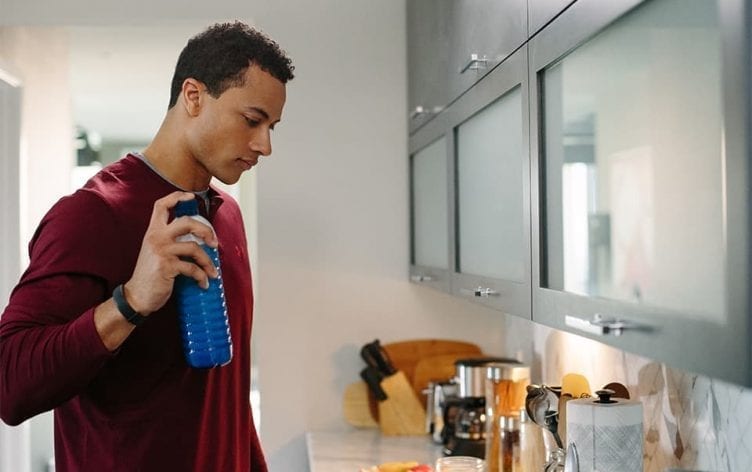
As you chug down your favorite sports drink after a long workout to rehydrate, have you ever wondered what exactly is in that bottle? To understand the effects of a sports drink on your body, take a look at the main components and what each one does to help your performance.
Water (92–94%)
This may seem intuitive, but good ol’ water is the key to rehydration! The goal is to drink enough fluid to replenish what was lost during activity, and the main component of sports drinks—water—allows for this.
Carbohydrates (6–8%)
At high intensities and for long-duration exercise, carbohydrates (sugars) are the primary fuel source for your muscles and brain. After exercising for longer than an hour, blood sugar and glycogen (your muscles’ energy reserves) levels begin to deplete. Because the body has limited carbohydrate stores, this is where a sports drink can come in handy.
Current guidelines from the Academy of Nutrition and Dietetics recommend that sports drinks contain a 6–8% carbohydrate concentration because this level is isotonic with blood (meaning they contain similar amounts of salt and sugar as blood), allowing the body to absorb the fluids faster.
If you want to reduce your sugar intake, there are numerous low-calorie, low-sugar and even sugar-free sports drink options on the market that do a great job at rehydrating, especially for shorter and lower intensity workouts. Since these options contain significantly less sugar than their higher-calorie counterparts, low-calorie or reduced-sugar sports drinks are less ideal for fueling muscles before, during and after particularly tough or long workouts.
Unlike a banana, which contains only two forms of sugar (fructose and glucose), sports drinks are designed to contain a mix of carbohydrates so that the sugar transporters in your gut do not become overwhelmed. Research has suggested that a blend of sugars, like glucose, sucrose, dextrose or fructose, allows your body to optimally absorb all sugars, meaning more carbohydrates get to your muscles as fuel.
While carbs can enhance performance, too many carbs during exercise overwhelm the gut and upset the digestive system. Most endurance athletes perform best when they eat about 30–60 grams of carbohydrates per hour. Keep in mind that carbohydrate replenishment during exercise is most important when exercise lasts longer than an hour.
Electrolytes (Less than 1%)
Sodium: The superstar of all electrolytes, as it’s lost in the greatest amount in sweat. Loss of sodium creates poor fluid balance and may lead to muscle cramps and, while rare, hyponatremia (i.e., blood sodium levels that are way lower than normal). While sodium has received much criticism in the Western diet, athletes often have higher sodium needs than the general population. The presence of sodium in a sports drink can enhance and maintain thirst, prompting more liquid consumption and hydration, which improves performance. For prolonged intense exercise, the presence of sodium will offset sodium lost in sweat and help the body maintain optimal blood volume. Sodium replenishment isn’t usually necessary for activities lasting less than an hour, unless you’re exercising in hot and humid environments or at high intensities.
Potassium: This important electrolyte plays a critical role in muscle contraction and regulating blood pressure. In conjunction with sodium, it can aid in preventing muscle cramps—a crucial aspect to performing your very best. While potassium losses are not as high as sodium losses in sweat, it is still important to replenish your potassium levels to maintain the proper electrolyte balance.
Magnesium and Calcium: These two electrolytes work in conjunction to aid muscle contractions—calcium allows for the contractions while magnesium allows your muscles to relax. The combination of these two electrolytes is crucial for optimal muscle function.
Additional Minerals
Some sports drinks also incorporate minerals, such as sodium bicarbonate. Sodium bicarbonate serves to buffer the lactic acid buildup (frequently felt as “muscle burn”) from performance, thus making the blood less acidic. This can delay the onset of fatigue and enhance endurance capacity.
3 Tips for Sipping Sports Drinks
Proper hydration is necessary before, during and after an intense workout. While plain water is an effective way of hydrating your body before activity, a sports drink can provide you with a needed energy and performance boost during a longer workout.
1. Two hours before a workout, drink 16 ounces of water. If planning on working out at a high intensity for a long duration, you may benefit from sports drinks or a high-electrolyte drink before training.
2. Aim to drink 4–6 ounces of water or a sports drink every 15–20 minutes. This will help you maintain good hydration. After prolonged activity, sports drinks quickly replenish levels of electrolytes lost to sweat, as well as help restore proper fluid balance.
3. For tough workouts lasting more than 1 hour, consider drinking 16 fluid ounces of a sports drink for every pound lost through sweat. Consuming sports drinks immediately following activity can be advantageous as compared to plain water if your electrolyte levels have been significantly depleted during the training session. With all the fluid-replacement options on the market, experiment with which drinks hydrate you the best for your workouts.



